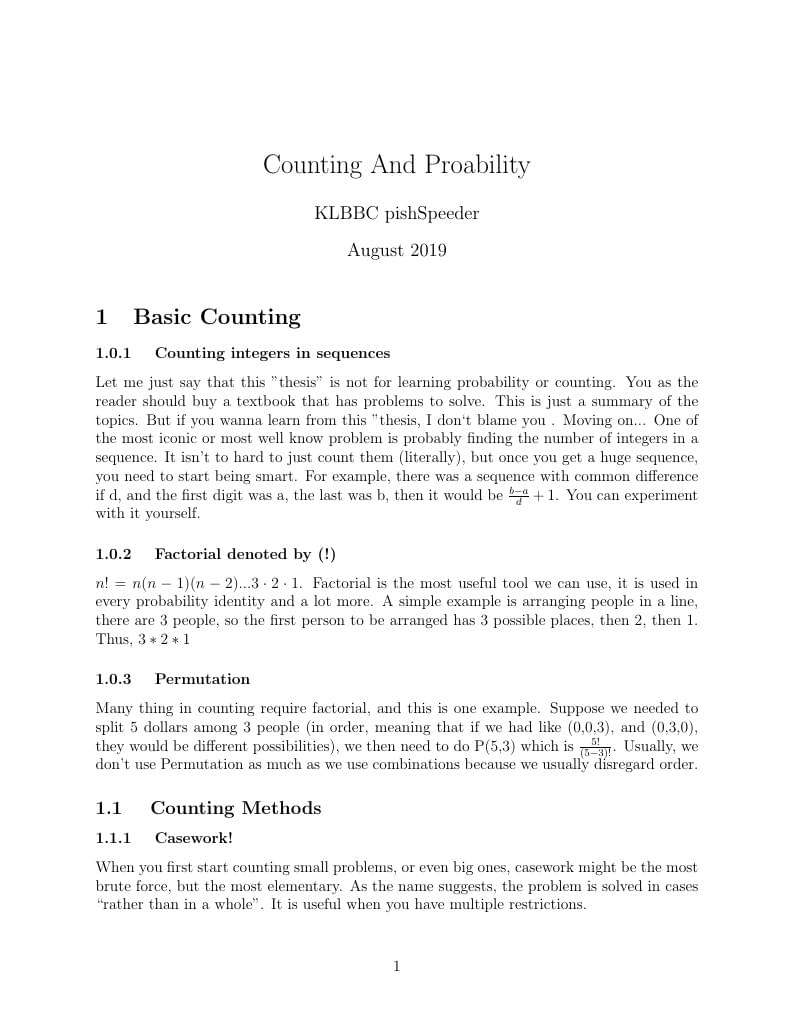
Counting And Proability
Author:
KLBBC
Last Updated:
6 лет назад
License:
Creative Commons CC BY 4.0
Аннотация:
counting and probablity

\begin
Discover why over 20 million people worldwide trust Overleaf with their work.
counting and probablity

\begin
Discover why over 20 million people worldwide trust Overleaf with their work.
\documentclass[12pt]{article}
\usepackage[margin=2.6cm]{geometry}
\usepackage[utf8]{inputenc}
\title{Counting And Proability}
\author{KLBBC pishSpeeder}
\date{August 2019}
\begin{document}
\maketitle
\section{Basic Counting}
\subsubsection{
Counting integers in sequences
}
Let me just say that this ”thesis” is not for learning probability or counting. You as the reader should buy a textbook that has problems to solve. This is just a summary of the topics. But if you wanna learn from this ”thesis, I don‘t blame you
. Moving on...
One of the most iconic or most well know problem is probably finding the number of integers in a sequence. It isn’t to hard to just count them (literally), but once you get a huge sequence, you need to start being smart. For example, there was a sequence with common difference if d, and the first digit was a, the last was b, then it would be $\frac{b-a}{d}+1$. You can experiment with it yourself.
\subsubsection{
Factorial denoted by (!)
}
$n! = n(n-1)(n-2)...3\cdot 2 \cdot 1$. Factorial is the most useful tool we can use, it is used in every probability identity and a lot more. A simple example is arranging people in a line, there are 3 people, so the first person to be arranged has 3 possible places, then 2, then 1. Thus, $3 * 2 * 1$
\subsubsection{
Permutation
}
Many thing in counting require factorial, and this is one example. Suppose we needed to split 5 dollars among 3 people (in order, meaning that if we had like (0,0,3), and (0,3,0), they would be different possibilities), we then need to do P(5,3) which is $\frac{5!}{(5-3)!}$. Usually, we don’t use Permutation as much as we use combinations because we usually disregard order.
\subsection{
Counting Methods
}
\subsubsection{
Casework!
}
When you first start counting small problems, or even big ones, casework might be the most brute force, but the most elementary. As the name suggests, the problem is solved in cases “rather than in a whole”. It is useful when you have multiple restrictions.
\subsubsection{
Complementary counting
}
Sometimes it is more useful to find the number of ways to not do something than to find the number of ways to do something. That is complementary counting. \newline Example: How many ordered (i.e. the order of the books matters) sets of three of the eight Anne of Green Gables
books are there if we insist that Anne of Avonela be one?
Solution. We instead count how many possible ordered sets do not have Anne of Avonela. There are seven possibilities for the first book, six for the second, and five for the third, for a total of 7 x 6 x 5 = 210 sets. Since there
are 8 x 7 x 6 = 336 possible ordered sets in total, exactly 336 - 210 = 126 of these sets will have them.
\end{document}